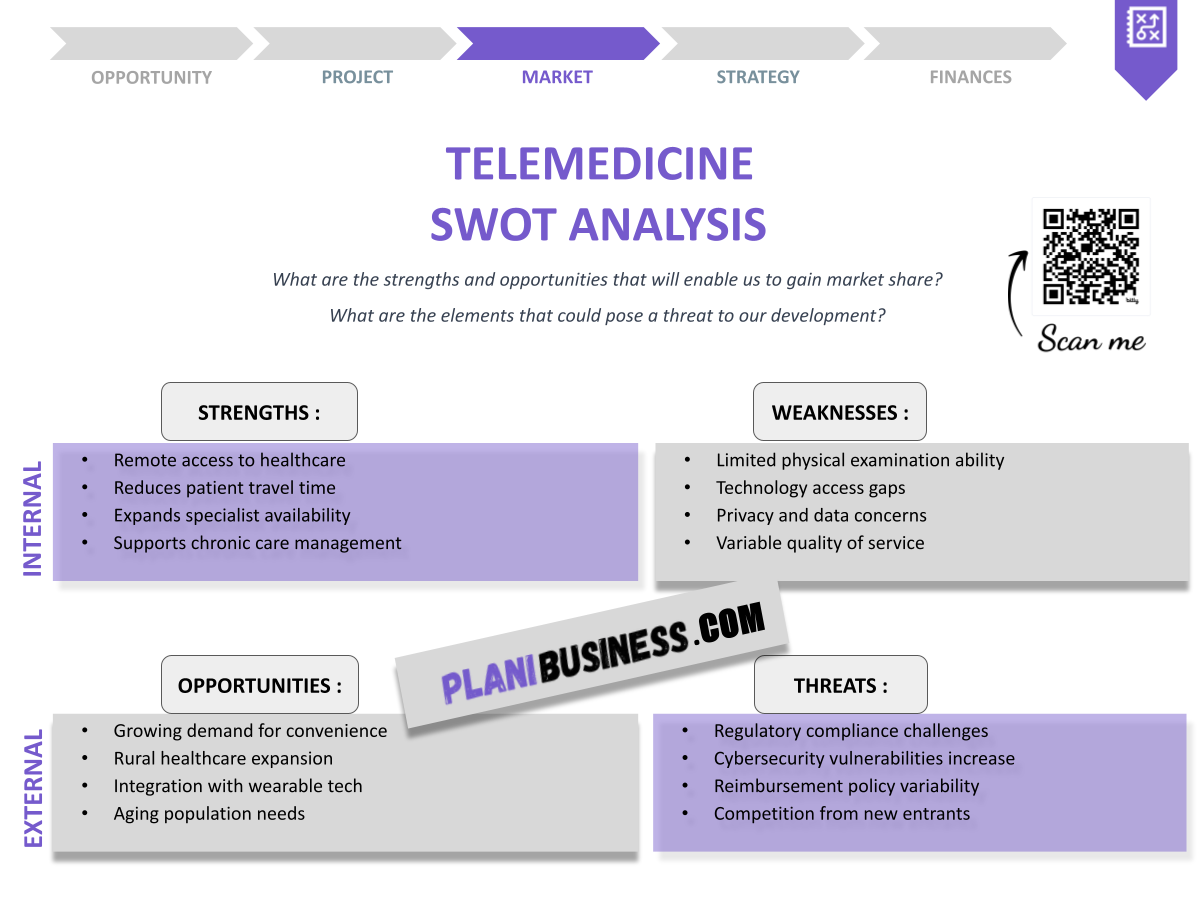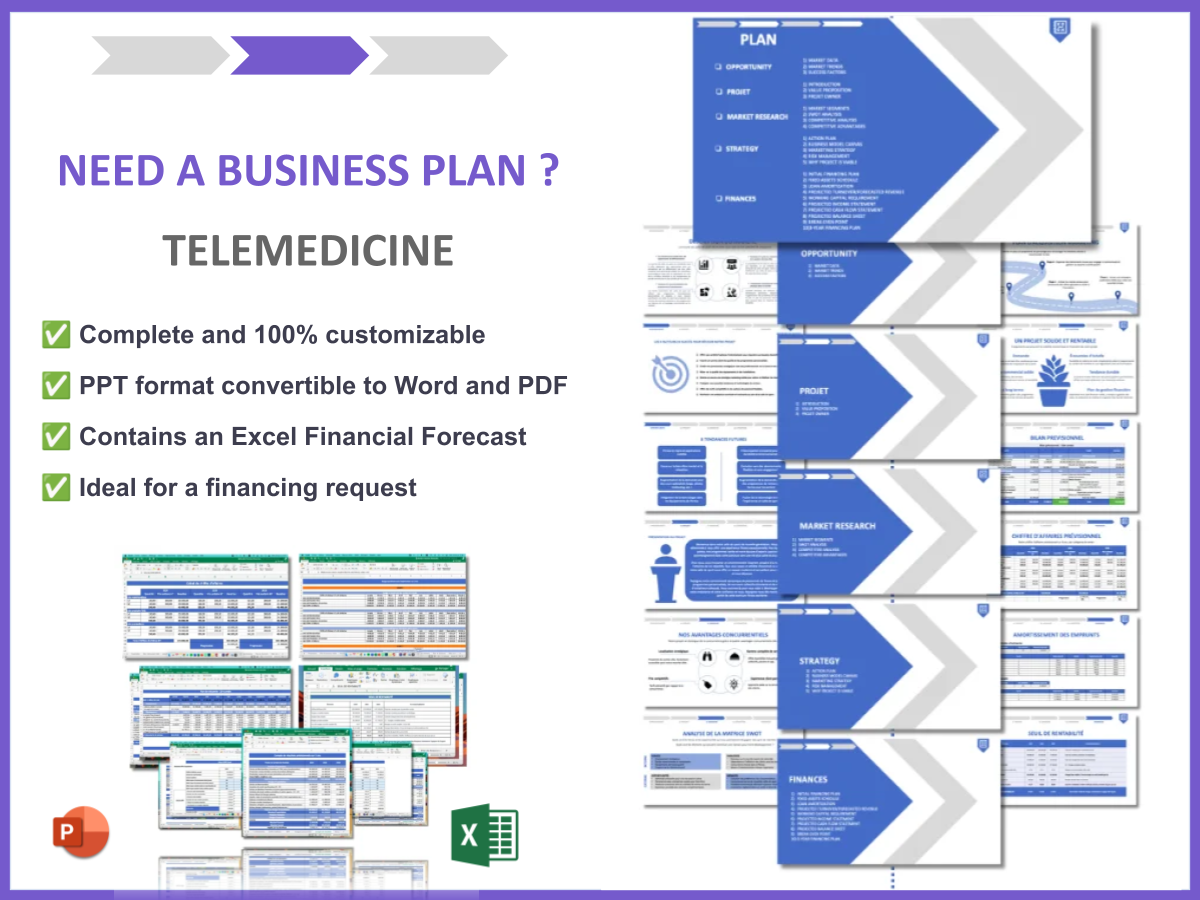Why Should You Have a SWOT Analysis for Telemedicine?
Are you aware that the telemedicine market is projected to reach $185.6 billion by 2026? That’s an astonishing growth rate! With such rapid expansion, it’s crucial for healthcare providers and entrepreneurs to understand the dynamics of this field. A SWOT analysis for telemedicine can illuminate the landscape, helping you identify key factors that can influence your strategy. In this section, we’ll dive into the importance of conducting a SWOT analysis in the telemedicine sector, defining what a SWOT analysis is and how it can shape your approach.
- Understanding market trends
- Identifying strengths and weaknesses
- Recognizing opportunities for growth
- Mitigating potential threats
- Strategic planning
- Competitive advantage
- Enhancing service delivery
- Improving patient satisfaction
- Aligning with regulatory standards
- Future-proofing your telemedicine practice
How Do You Write a SWOT Analysis for Telemedicine?
Creating a SWOT analysis for telemedicine involves systematic evaluation. Here’s a breakdown of how to approach it:
Strengths
The telemedicine sector boasts numerous strengths, including the ability to provide healthcare access to underserved areas. This is particularly crucial for patients who have difficulty reaching physical healthcare facilities.
Another strength is the convenience of virtual consultations. Patients can connect with healthcare professionals from the comfort of their homes, which can enhance patient engagement and adherence to treatment plans.
Telemedicine can lead to cost savings for both providers and patients. Reduced overhead costs for healthcare facilities can translate into lower fees for patients, making healthcare more affordable.
The technology behind telemedicine is continually evolving, with advancements in AI and data analytics improving diagnosis and treatment options.
Weaknesses
One of the primary weaknesses of telemedicine is the potential for technological barriers. Not all patients have access to the necessary devices or internet connections, which can limit service reach.
There’s also a lack of personal interaction in virtual consultations, which may hinder the doctor-patient relationship and affect the quality of care.
Regulatory issues can pose challenges, as varying state laws can complicate the practice of telemedicine across different jurisdictions.
Privacy concerns are another weakness, as patients may fear that their sensitive health information could be compromised during virtual consultations.
Opportunities
The growing acceptance of telemedicine presents an opportunity to expand services and reach new patient demographics.
Partnerships with tech companies can lead to innovative solutions, enhancing the telemedicine experience for both providers and patients.
There’s potential for telemedicine to integrate with wearable health technology, allowing for continuous monitoring and more personalized care.
Increased awareness of mental health issues has opened the door for teletherapy services, providing a valuable service to those in need.
Threats
The rise of competition in the telemedicine space can threaten market share, as new entrants continually emerge with innovative solutions.
Cybersecurity threats are a significant concern, as the increase in digital health services makes sensitive data more vulnerable to breaches.
Changing regulations can create uncertainty, requiring constant adaptation from telemedicine providers to remain compliant.
Economic downturns can lead to reduced patient spending on non-essential services, impacting telemedicine usage.
SWOT Example N°1 for Telemedicine Provider A
Provider A has successfully navigated the telemedicine landscape by leveraging its strengths and addressing weaknesses. This provider is known for its robust platform that offers a wide range of services, making it a key player in the industry.
| SWOT | Analysis |
|---|---|
| Strengths | Established reputation, strong technology infrastructure |
| Weaknesses | Limited service offerings, high operational costs |
| Opportunities | Partnerships with local hospitals, expanding service areas |
| Threats | Increasing competition from startups |
- Strong brand recognition
- Robust tech platform
- Opportunity for service expansion
- Competitive pricing strategies
Provider A’s established reputation allows them to attract a loyal patient base. They can capitalize on their strengths by forming partnerships with local hospitals to enhance service offerings.
SWOT Example N°2 for Telemedicine Provider B
Provider B has carved a niche in mental health teletherapy, making the most of current trends. By focusing on mental health, this provider has managed to tap into a growing market that increasingly values accessible care.
| SWOT | Analysis |
|---|---|
| Strengths | Specialized services in mental health |
| Weaknesses | High therapist turnover |
| Opportunities | Growing demand for mental health services |
| Threats | Regulatory changes affecting teletherapy |
- Specialization in mental health
- Innovative therapy options
- Increased patient demand
- Need for regulatory compliance
Provider B’s focus on mental health positions them well in a growing market. Their ability to adapt to regulatory changes will be crucial in maintaining their competitive edge.
SWOT Example N°3 for Telemedicine Provider C
Provider C is a newcomer but has quickly gained traction through innovative technology. By leveraging cutting-edge solutions, this provider stands out in the crowded telemedicine market.
| SWOT | Analysis |
|---|---|
| Strengths | Cutting-edge technology, user-friendly interface |
| Weaknesses | Limited brand recognition |
| Opportunities | Partnerships with tech firms |
| Threats | Established competitors |
- Innovative service offerings
- User-friendly platform
- Potential for partnerships
- Need to build brand awareness
Despite being new, Provider C’s technology sets them apart. They should focus on building brand awareness through marketing campaigns to compete effectively.
SWOT Example N°4 for Telemedicine Provider D
Provider D has leveraged its extensive network of healthcare professionals to offer a wide range of services. This provider excels in integrating various specialties into their telemedicine platform, enhancing patient care.
| SWOT | Analysis |
|---|---|
| Strengths | Wide network of professionals |
| Weaknesses | Higher operational costs |
| Opportunities | Cross-specialty collaborations |
| Threats | Market saturation |
- Comprehensive service offerings
- Collaboration opportunities
- High operational costs
- Need to differentiate in a crowded market
Provider D’s extensive network is a significant advantage. However, they must find ways to manage costs while maintaining service quality to thrive.
SWOT Example N°5 for Telemedicine Provider E
Provider E focuses on chronic disease management through telemedicine, catering to a specific patient demographic. By concentrating on chronic conditions, this provider has established itself as a leader in a vital area of healthcare.
| SWOT | Analysis |
|---|---|
| Strengths | Niche focus on chronic diseases |
| Weaknesses | Limited service diversity |
| Opportunities | Growing chronic disease prevalence |
| Threats | Regulatory scrutiny |
- Specialized chronic disease management
- Strong patient outcomes
- Limited service offerings
- Need to adapt to regulations
Provider E’s niche focus allows them to excel in chronic disease management. They should consider expanding their service offerings to attract a broader patient base.
SWOT Example N°6 for Telemedicine Provider F
Provider F has utilized social media to enhance patient engagement and outreach. By effectively leveraging digital platforms, this provider has built a strong community around their telemedicine services.
| SWOT | Analysis |
|---|---|
| Strengths | Strong social media presence |
| Weaknesses | Inconsistent patient feedback |
| Opportunities | Increased online marketing |
| Threats | Negative online reviews |
- Effective patient outreach
- Engaged community
- Need for consistent feedback management
- Risk of negative publicity
Provider F’s social media strategy is a strong point, but they must ensure consistent quality in service to avoid negative feedback.
SWOT Example N°7 for Telemedicine Provider G
Provider G is known for its user-centric design, making telehealth accessible to all. By prioritizing user experience, this provider has successfully attracted a diverse patient base.
| SWOT | Analysis |
|---|---|
| Strengths | User-friendly platform |
| Weaknesses | Limited marketing budget |
| Opportunities | Growing demand for accessible healthcare |
| Threats | Competition from larger budgets |
- Accessibility focus
- High user satisfaction
- Budget constraints
- Competition from larger players
Provider G’s user-centric approach is commendable. They need to explore cost-effective marketing strategies to increase visibility in a competitive market.
SWOT Example N°8 for Telemedicine Provider H
Provider H has integrated telemedicine into traditional healthcare practices, enhancing continuity of care. This innovative approach allows for seamless transitions between in-person and virtual visits.
| SWOT | Analysis |
|---|---|
| Strengths | Integration with traditional care |
| Weaknesses | Resistance from some healthcare providers |
| Opportunities | Seamless patient transitions |
| Threats | Potential pushback from traditionalists |
- Integrated care model
- Enhanced patient experience
- Resistance from providers
- Need for advocacy
Provider H’s integration model offers a seamless patient experience, but they must work on overcoming resistance from traditional healthcare providers.
SWOT Example N°9 for Telemedicine Provider I
Provider I has focused on preventative care, leveraging telemedicine to reach patients early. By emphasizing prevention, this provider has positioned itself as a proactive force in healthcare.
| SWOT | Analysis |
|---|---|
| Strengths | Focus on preventative care |
| Weaknesses | Limited immediate care options |
| Opportunities | Increased focus on health education |
| Threats | Changing patient preferences |
- Strong preventative focus
- Educational initiatives
- Limited service offerings
- Need to adapt to patient needs
Provider I’s emphasis on preventative care is a strong strategy. However, they should consider diversifying their service offerings to meet varying patient needs.
SWOT Example N°10 for Telemedicine Provider J
Provider J has established a unique telemedicine model that combines in-person and virtual visits. This hybrid approach enhances flexibility for patients and providers alike.
| SWOT | Analysis |
|---|---|
| Strengths | Hybrid service model |
| Weaknesses | Complexity in scheduling |
| Opportunities | Flexibility for patients |
| Threats | Competition from pure telehealth providers |
- Innovative hybrid model
- Increased patient flexibility
- Scheduling challenges
- Need for clear communication
Provider J’s hybrid model offers flexibility but requires a robust scheduling system to manage both in-person and virtual visits efficiently.
Conclusion
In summary, conducting a SWOT analysis for telemedicine is essential for understanding the intricate dynamics of this rapidly evolving field. By identifying strengths, weaknesses, opportunities, and threats, telemedicine providers can develop effective strategies to enhance their services and meet patient needs. Don’t wait; start your SWOT analysis today and position your telemedicine practice for success!
If you’re looking for a solid foundation for your business, consider checking out this business plan template for telemedicine. It offers a comprehensive guide to launching your practice effectively. Additionally, explore our articles on How to Initiate a Telemedicine Business? and How to Create a Telemedicine Marketing Plan? With Example to gain more insights into establishing and promoting your telehealth services.
FAQ
What is a SWOT analysis?
A SWOT analysis is a strategic tool used to assess the strengths, weaknesses, opportunities, and threats related to a business or project, helping to inform decision-making.
Why is SWOT analysis important in telemedicine?
It enables healthcare providers to understand their competitive position in the telemedicine market and formulate strategies to enhance patient care and operational efficiency.
How often should a SWOT analysis be conducted?
It is advisable to conduct a SWOT analysis annually or whenever there are significant changes in the market or organization that could impact operations.
Can telemedicine be a threat to traditional healthcare?
Yes, while telemedicine offers numerous advantages, it can create competition for traditional healthcare providers, particularly for routine care services.
What are common weaknesses in telemedicine?
Common weaknesses include technological barriers, inadequate personal interaction in virtual visits, and varying regulatory challenges across different regions.
How can telemedicine providers improve their strengths?
Providers can enhance their strengths by investing in advanced technology, training their staff, and fostering strong relationships with patients to ensure satisfaction.
What opportunities exist for telemedicine?
Opportunities include expanding into new markets, integrating with innovative technologies, and addressing the rising demand for mental health services.
What threats should telemedicine providers be aware of?
Providers should be vigilant about increasing competition, potential regulatory changes, and cybersecurity threats that may compromise patient data.
How can telemedicine improve patient satisfaction?
By providing convenience, accessibility, and personalized care options, telemedicine can significantly enhance the overall patient experience.
What does the future hold for telemedicine?
The future of telemedicine looks promising, with continuous growth expected as technology evolves and healthcare needs change.







